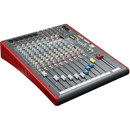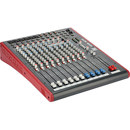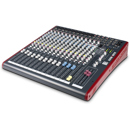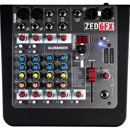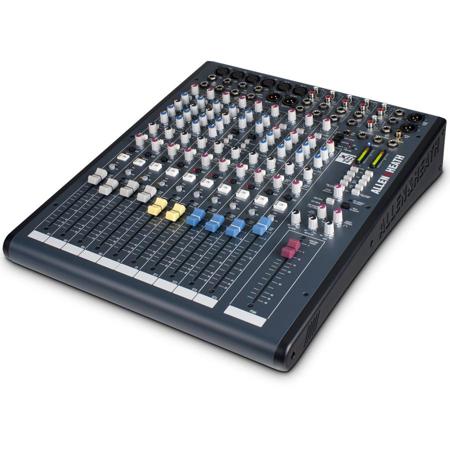
Allen & Heath XB-14 2 Compact Radio Broadcast Mixer
SKU: AHAHXB142
This item is no longer available.
Recommended Alternatives
Share:
Overview
Compare
Specs
Protection
Q&A
Questions & Answers
Reviews about this item
Review Summary
Select a plan in the Add Protection section above and purchase with this product by clicking “Add to Cart”.
TRUSTED PROTECTION PLANS, EXCEPTIONAL SERVICE.
Invest In Your Gear and Peace Of Mind!
Accidents happen. Protect your favorite Adorama products and purchase a protection plan to stay covered from accidental damage, mechanical or electrical failures, and more.
Repair or Replacement
If we can’t fix it, we’ll replace it at no additional cost.
Accidental Damage
Protect your product from drops, spills, and more.
Peace of Mind
Enjoy your gear without fear. We have you covered!
Failure Protection
When regular use of your product over time results in mechanical or electrical failure.
Zero Deductible
We will never charge you a deductible after the purchase of a plan.
Customer-Focused Support
Our claims process is simple & easy and our customer service team is happy to help.
Adorama Protect powered by Extend is available for purchase to customers in the United States. Not available for international or U.S. territories purchases. Plans on open box items do not cover pre-existing damage.
Adorama Protect plans are available for ABS clients. If you have any questions or require assistanse, please call 800-223-2500
Browse our FAQ
Allen & Heath XB-14 2 Specifications
Inputs
Mono Channel Microphone Input (XLR): +6 to -63 dBu for Nominal (+17 dBu Maximum)
Mono Channel Line Input (TRS Jack Socket): +10 to -26 dBu (+30 dBu Maximum)
Stereo Input (TRS Jack and RCA Sockets): 0 dBu Nominal (Control = Off to +10 dBu)
Telco Channel Input (XLR): +10 to -26 dBu (+30 dBu Maximum)Outputs
PGM L/R Outputs (XLR): +4 dBu Nominal (+25 dBu Maximum)
PGM Mono Output (RCA Phono): 0 dBu Nominal (+21 dBu Maximum)
Aux Output (Jack Socket: 0 dBu Nominal (+21d Bu Maximum)
Mix B, Audition and CRM Outputs (RCA Phono Sockets): 0 dBu Nominal (+21 dBu Maximum)
Telco Output (XLR): 0 dBu Nominal (+21 dBu Maximum)USB Audio
CODEC:
USB Audio In/Out: USB 1.1 Compliant 16 bit
Sample Rate: 32, 44.1 or 48 kHzTHD + N
Microphone in to PGM L/R Out, 0 dB Gain 1 kHz + 10 dBu Out: 0.001%
Noise
Microphone Pre EIN at Maximum Gain 150R Input Z: 22 Hz-22 kHz, -124 dBu
PGM Out, PGM Fader Nominal: 22 Hz-22 kHz, -100 dBu
Aux Out, Alt Out, Rec Out Nominal: 22 Hz-22 kHz, <-85 dBu Audition out, Mix B out = 0, 22 Hz-22 kHz < -100 dBuCrosstalk / Attenuation 1
Mono fader attenuation (dB relative to +10 dBu) 1 kHz/10 kHz -95/-95
Mono ON switch attenuation (dB relative to +10 dBu) 1 kHz/10 kHz -95/-95
TELCO fader attenuation (dB relative to +10 dBu) 1 kHz/10 kHz -95/-95
TELCO ON switch attenuation (dB relative to +10 dBu) 1 kHz/10 kHz -95/-95Crosstalk / Attenuation 2
Stereo fader attenuation (dB relative to +10 dBu) 1 kHz/10 kHz -95/-90
Stereo ON switch attenuation (dB relative to +10 dBu) 1k Hz/10 kHz -95/-95
PGM fader attenuation (dB relative to +10 dBu) 1 kHz/10 kHz -100/-95
TELCO clean-feed isolation from I/P (dB relative to +10 dBu) 1 kHz/10 kHz -55/-40
Stereo separation, L in to PGM R out. dBr 1 kHz/10 kHz -70/-50Headroom
Analog Headroom from Nominal (OVu) Outputs: 21 dB
Analog Headroom from Nominal (OVu) Mix Point: 24 dB
USB In/Out Headroom from Nominal (OVu): 14 dBFrequency Response
Microphone In to PGM L/R Out: 30 dB Gain, +0.5/-1 dB 10 Hz-30 kHz
Line In to PGM L/R Out: 0 dB Gain, +0.5/-1 dB 10 Hz-20 kHz
Stereo In to PGM L/R Out: +0.5/-1 dB 10 Hz-30 kHz
About Allen & Heath XB-14 2
XB-142 offers a host of specialized broadcast features that normally come at a much higher price, including telephone communication (telco) channels, mic channel ON switch sensing, stereo channel start/cue outputs for playback device control, automatic muting of speaker outputs and much more. XB-14-2 incorporates new features and styling based on feedback from the many broadcasters who have built their operations around the original XB-14. With a wealth of routing options, dual stereo channels for up to 7 stereo sources and the addition of a dedicated Audition bus, enhanced microphone preamps and stereo channel gain range, XB-142 satisfies the demands of small radio and internet broadcasters as well as larger studios with multiple rooms. With no less than 27 logic I/O for remote control and 15 configuration switches, XB-14-2 is a highly flexible solution.
• 4 mic/line channels
• 4 Dual Source stereo channels
• 2 Telco channels
• HPF and 3-band, swept mid EQ on mono channels
• 2-band EQ on stereo channels
• Variable high pass / low pass filters on Telco channels
• Smooth-ride 100mm faders
• 2-stage, padless pre-amp design
• Fader-start sensing on mono channels
• Start/cue logic outputs on stereo channels
• External meter socket
• Separate headphones mix for engineer/producer and 2 guests
• Auto mutes on control room outputs
• Remote mute facility on mic channels
• Configurable USB stereo audio in/out
• Audition bus for auditioning and off-air recording
• Aux and separate stereo busses for processing/recording
• XLR main outputs with inserts
• Input signal and peak metering
Self / Producer Operated
Whether you need a mixer for a self-operated broadcast situation or whether you have a separate studio and engineer, the XB series has features to fit. Separate monitor mixes can be created for operator and guests or presenter, so the engineer can check levels and cue sources while the presenter or guest can listen to a different source. The engineer/producer can communicate to the guest or presenter using the Talk feature, as well as speaking off-air with telephone callers. There is also the facility for remote control of channel mutes from the studio using the remote interface connectors - ideal for studio situated mute or 'cough' switches.
Duopre Preamps
The XB-142 pre-amps use a two stage design, with carefully controlled amounts of gain in each stage. When amplifying the signal from the XLR input, the gain range is huge (69dB of range to be exact) and is very evenly distributed around the gain control, meaning better control of signal level. There is no "pad" switch or pad circuit - line level signals are simply plugged into the second stage of the pre-amp by using the line input jack socket. This has the great advantage of lower noise when using the line input.
USB
XB-142 comes with a full duplex USB soundcard built-in and many useful routing options for recording and broadcast applications.
Audition Bus
The dedicated stereo audition bus can be used for auditioning or off air recording. Pressing the button marked AUD on the channels required transfers the mix from the program feed over to the audition bus.
TELCO
The two Telco channels provide a selectable clean-feed output (LR PGM, Aux or Audition bus), variable high pass and low pass filters to reduce the frequency range of the channel when used with a telephone caller and TALK button.
What's in the box:
- Allen & Heath XB-14 2 Radio Broadcast Mixer
- Allen & Heath 1 Year Limited Warranty
